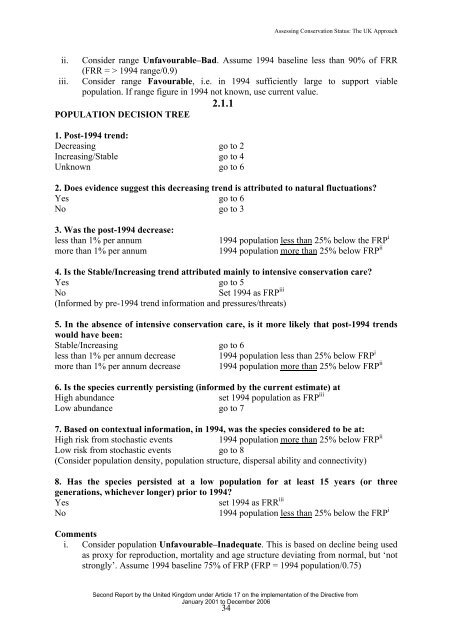Assessing Conservation Status: The UK Approach - JNCC
Assessing Conservation Status: The UK Approach - JNCC
Assessing Conservation Status: The UK Approach - JNCC
You also want an ePaper? Increase the reach of your titles
YUMPU automatically turns print PDFs into web optimized ePapers that Google loves.
<strong>Assessing</strong> <strong>Conservation</strong> <strong>Status</strong>: <strong>The</strong> <strong>UK</strong> <strong>Approach</strong><br />
ii. Consider range Unfavourable–Bad. Assume 1994 baseline less than 90% of FRR<br />
(FRR = > 1994 range/0.9)<br />
iii. Consider range Favourable, i.e. in 1994 sufficiently large to support viable<br />
population. If range figure in 1994 not known, use current value.<br />
2.1.1<br />
POPULATION DECISION TREE<br />
1. Post-1994 trend:<br />
Decreasing go to 2<br />
Increasing/Stable go to 4<br />
Unknown go to 6<br />
2. Does evidence suggest this decreasing trend is attributed to natural fluctuations?<br />
Yes go to 6<br />
No go to 3<br />
3. Was the post-1994 decrease:<br />
less than 1% per annum<br />
more than 1% per annum<br />
1994 population less than 25% below the FRP i<br />
1994 population more than 25% below FRP ii<br />
4. Is the Stable/Increasing trend attributed mainly to intensive conservation care?<br />
Yes go to 5<br />
No<br />
Set 1994 as FRP iii<br />
(Informed by pre-1994 trend information and pressures/threats)<br />
5. In the absence of intensive conservation care, is it more likely that post-1994 trends<br />
would have been:<br />
Stable/Increasing go to 6<br />
less than 1% per annum decrease 1994 population less than 25% below FRP i<br />
more than 1% per annum decrease 1994 population more than 25% below FRP ii<br />
6. Is the species currently persisting (informed by the current estimate) at<br />
High abundance<br />
iii<br />
set 1994 population as FRPP<br />
Low abundance go to 7<br />
7. Based on contextual information, in 1994, was the species considered to be at:<br />
High risk from stochastic events<br />
1994 population more than 25% below FRP ii<br />
Low risk from stochastic events go to 8<br />
(Consider population density, population structure, dispersal ability and connectivity)<br />
8. Has the species persisted at a low population for at least 15 years (or three<br />
generations, whichever longer) prior to 1994?<br />
Yes<br />
set 1994 as FRR iii<br />
No<br />
1994 population less than 25% below the FRP i<br />
Comments<br />
i. Consider population Unfavourable–Inadequate. This is based on decline being used<br />
as proxy for reproduction, mortality and age structure deviating from normal, but ‘not<br />
strongly’. Assume 1994 baseline 75% of FRP (FRP = 1994 population/0.75)<br />
Second Report by the United Kingdom under Article 17 on the implementation of the Directive from<br />
January 2001 to December 2006<br />
34
















